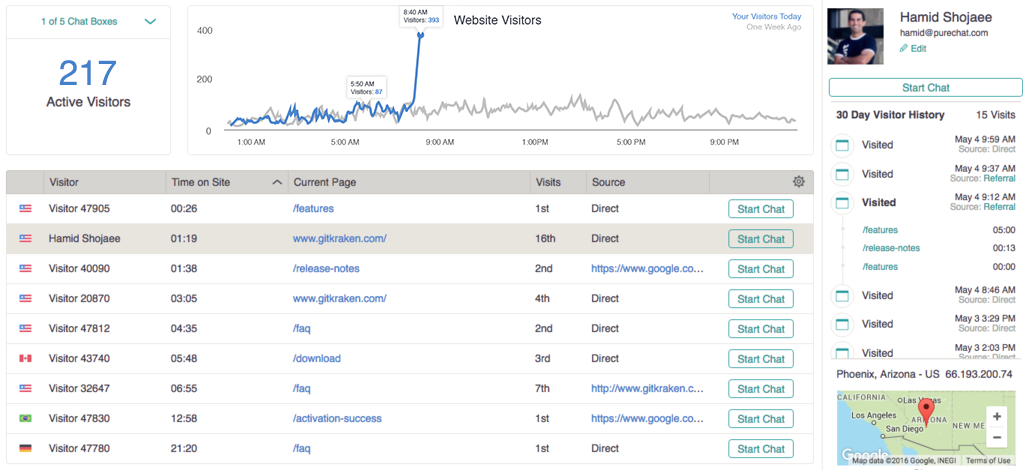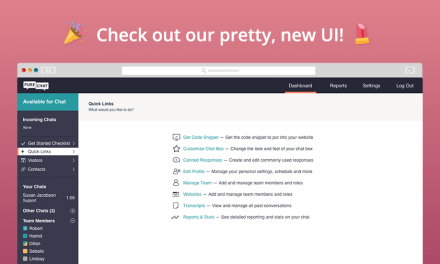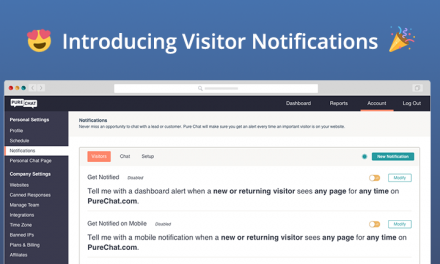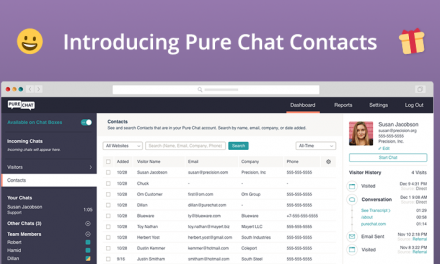I have been doing email marketing, through the use of newsletters (or email blasts) for nearly 20 years. So I was shocked when in less than 2 hours, my view of how email marketing works changed dramatically.
Last week, the Axosoft team installed Pure Chat Visitor Tracking code on GitKraken.com, a popular git client, and proceeded to send out an email blast to the newsletter subscribers of the site. Having realtime visitor tracking on the site, I was curious as to what the newsletter would do to the traffic in realtime, so of course, I tuned in closely to see what was going to happen:

As they were preparing to send out the newsletter, I could see that the realtime visitor count was hovering in the 80s. That means there were approximately 80 people on the site in a typical 5-minute interval before the newsletter was sent.
Then this happened:

The Send button on the GitKraken newsletter had been pushed. In these graphs, the grey line shows the previous week’s same day traffic. Meaning a Monday is compared to a Monday, a Wednesday to a Wednesday and so on. As you can see, the newsletter was working! The website jumped to nearly 400 visitors on the site the moment the newsletter went out. To be more precise, it jumped to 393 visitors in a 5-minute interval within 5 minutes of hitting the [Send] button on the newsletter. BAM! The newsletter was working, just as one would suspect. I was impressed by the immediacy of the results and seeing the graph made me feel good about what was happening.
It was also interesting to watch what people did while they were on the site. Pure Chat shows the pages each visitor hits, how long they stay, whether they have been on the site before and the navigation path of each visit.The entire Pure Chat Visitor Dashboard looks like this:

Of course, the name and email information is only obtained if you’ve had a conversation with the visitor and requested that information, but being able to see the navigation path of even anonymous visitors helped me learn so much about the website design and issues that a user might face.
As I was soaking in everything that I was learning about what each visitor was doing on the site, I noticed something interesting. Within a couple of hours of when the newsletter was sent, the traffic to the site had already normalized:

From this graph, it’s easy to see that two hours after the newsletter had been sent, traffic to the site was indistinguishable from normal traffic. This was hard to believe as the audience for this newsletter is an international audience with more than 1/2 of the newsletter subscribers being outside of the US. Considering there are a couple of dozen time zones in the world, I would have expected a slower curve of traffic reduction that might be noticeable as much as 24 hours after the newsletter was sent. Nope. Two hours later, the traffic pattern looked normal.
That was hard to believe. Surely there would continue to be people who clicked on the newsletter links over the next 24 hours, and yes, the realtime analytics confirmed this suspicion, but the numbers were no longer large enough to be noticeable compared to normal traffic.
I had to see if this was true for other sites. I watched what happens when a newsletter was sent for Axosoft.com, and the results were similar. Then I watched as we sent out a newsletter for PureChat.com and sure enough, the traffic pattern repeats itself.
So what does this tell you about newsletter marketing? Well, here are some of the best practices that I took away:
- Prepare For the Traffic Boost – If you are planning any site changes, navigation changes or other updates, be sure to do them well before the newsletter goes out and test everything extensively to ensure you are prepared for the traffic boost. If somethings goes wrong with your site after a newsletter is sent, your window to fix problems and still benefit from the traffic boost of a newsletter is extremely small.
- Live Chat Operators Should be Ready – If you provide live chat on your site (and you should if you have a business website), it’s smart to have all operators ready to go before the newsletter is sent and give them a heads up as to when the newsletter will be sent. This is huge as the bulk of your chat requests will come in within 10 minutes of the newsletter going out. If they happen to be on a short break, you could miss the opportunity to chat with your best leads.
- Send During Business Hours – All indications are that the biggest opportunity for engagement with an email blast comes if the recipient happens to be checking email when you send out the blast. The likelihood that they are checking emails during business hours is a lot greater than any other time.
- Separate International Emails Into a Different Blast – Similar to sending email blasts during business hours, if you can partition your list based on geographical location of your users, that would be ideal. You can then send each group’s email based on the most likelihood time they would be checking email.
But one of the most interesting things that comes from having a realtime pulse of what is happening on your website is that you get to see trends and problems much more quickly than was possible ever before. The newsletter insights is just one example of the benefits of realtime analytics.
You can install Pure Chat Visitor Tracking on your website 100% Free. Install it Now. It takes less than 3 minutes!







Great post, point understood. But I think it was a bit exaggerated. You do e-mail marketing for nearly 20 years and surprised to see that people actually click on the links, and they do it when they receive the e-mail? What software do you use to send campaigns, that doesn’t provide this?
I’ve been too removed from the actual sending of the emails for some time…I believe our team uses customer.io now. While I have known for a long time that the effects of an email are fairly quick and don’t last long, it is quite surprising to see how immediate it is and how short it lasts.